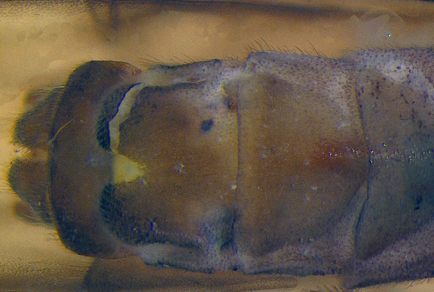Abstract
The Louisiana Needlefly, Leuctra szczytkoi Stark & Stewart, 1981, was one of 404 species petitioned in 2010 by the Center for Biological Diversity for inclusion and protection under the United States Endangered Species Act. There were only four known locality records in northern and central Louisiana before the start of this project, all collected between 1973 and 1997. Prior published research, however, provided tangible evidence that L. paleo Poulton & Stewart, 1991 could be a junior synonym of L. szczytkoi. The type localities of these two species (L. paleo—southern Arkansas; L. szczytkoi—northern Louisiana) are only separated by approximately 120 km. The primary objective of this study was to use mitochondrial cytochrome C oxidase subunit 1 gene sequences to assess the taxonomic validity of L. paleo using tree- and genetic distance-based phylogenetic analyses. Results of all analyses provide consistent and strong evidence that L. paleo is a junior synonym of L. szczytkoi. Hence, L. szczytkoi has nomenclatural priority with an expanded known distribution now from southern Arkansas southward to central Louisiana and southwestward to east Texas with 20 unique locations. Additional notes on other members of the L. ferruginea (Walker, 1852) group are provided.
References
- Bojková, J., Komprdova, K., Soldán, T. & Zahrádková, S. (2012) Species loss of stoneflies (Plecoptera) in the Czech Republic during the 20th century. Freshwater Biology, 57, 2550–2567. https://doi.org/10.1111/fwb.12027
- Center for Biological Diversity (CBD 2010) Petition to list 404 aquatic, riparian and wetland species from the southeastern United States as threatened or endangered under the Endangered Species Act.
- DeWalt, R.E. & Stark, B.P. (1996) Descriptions of the female, nymph, and variation in male characters of the stonefly Leuctra szczytkoi (Plecoptera: Leuctridae). Entomological News, 107, 61–67.
- DeWalt, R.E., Favret, C. & Webb, D.W. (2005) Just how imperiled are aquatic insects? A case study of stoneflies (Plecoptera) in Illinois. Annals of the Entomological Society of America, 98, 941–950. https://doi.org/10.1603/0013-8746(2005)098[0941:JHIAAI]2.0.CO;2
- DeWalt, R.E., Maehr, M.D., Hopkins, H., Neu-Becker, U. & Stueber, G. (2022) Plecoptera Species File Online. Version 5.0/5.0. Available from: http://Plecoptera.SpeciesFile.org. (accessed 17 July 2022)
- Dunn, R.R. (2005) Modern insect extinctions, the neglected majority. Conservation Biology, 19, 1030–1036. https://doi.org/10.1111/j.1523-1739.2005.00078.x
- Giersch, J.J., Jordan, S., Luikart, G., Jones. L.A., Hauer, F.R. & Muhlfeld, C.C. (2015) Climate-induced range contraction of a rare alpine aquatic invertebrate. Freshwater Science, 34, 53-65. https://doi.org/10.1086/679490
- Grubbs, S.A. (2010) Leuctra usdi n. sp., a new stonefly (Plecoptera: Leuctridae) of the L. tenuis (Pictet) species group from the southeastern U.S.A. plus three new Alabama state records. Zootaxa, 2498, 59–64. https://doi.org/10.11646/zootaxa.2498.1.5
- Grubbs, S.A. (2015) Leuctra schusteri, a new stonefly species (Plecoptera: Leuctridae) of the L. tenuis (Pictet) group from the southeastern U.S.A. Illiesia, 11, 147–166.
- Grubbs, S.A. & Sheldon, A.L. (2009) Leuctra pinhoti, a new species of stonefly (Plecoptera: Leuctridae) from Alabama, U.S.A. Illiesia, 5, 195–198.
- Grubbs, S.A., Metzger, M.L. & Wei, S. (2020) Systematics of eastern Nearctic Leuctra moha Ricker, 1952 with notes on L. hicksi Harrison & Stark, 2010 (Plecoptera: Leuctridae). Zootaxa, 4768, 361–373. https://doi.org/10.11646/zootaxa.4768.3.3
- Hallmann, C.A., Zeegers, T., van Klink, R., Vermeulen, R., van Wielink, P., Spijkers, H., van Deijk, J., van Steenis, W. & Jongejans, E. (2020) Declining abundance of beetles, moths and caddisflies in the Netherlands. Insect Conservation and Diversity, 13, 127–139. https://doi.org/10.1111/icad.12377
- Harper, P.P. & Harper F. (1997) The genus Leuctra Stephens in North America: a preliminary report. In: Landolt, P. & Sartori, M. (Eds.), Ephemeroptera and Plecoptera: biology–ecology–systematics. Mauron, Tinguely and Lachat, SA, Fribourg, Switzerland, pp. 467–472.
- Harrison, A.B. & Stark B.P. (2010) Two new species of stoneflies in the Leuctra ferruginea group (Plecoptera: Leuctridae), with notes on the Leuctra species known for Mississippi and Alabama, U.S.A. Illiesia, 6, 16–33.
- Hebert, P.D., Cywinska, A., Ball, S.L. & deWaard, J.R. (2003) Biological identifications through DNA barcodes. Proceedings of the Royal Society London, Series B, 270(1512), 313–321. https://doi.org/10.1098/rspb.2002.2218
- Master, L.L., Stein, B.A., Kutner, L.S. & Hammerson, G.A. (2000) Vanishing assets, conservation status of U.S. species. In: Stein, B.A., Kutner, L.S. & Adams, J.S. (Eds). Precious Heritage, The Status of Biodiversity in the United States. Oxford University Press, New York, pp. 93–118. https://doi.org/10.1093/oso/9780195125191.003.0010
- Metzger, M.L., Grubbs, S.A. & Johnson, J.R. (2022) An integrative phylogenetic analysis of eastern Nearctic Leuctra (Plecoptera: Leuctridae), with an emphasis on the fauna of a southern Appalachian Highlands landscape. Canadian Entomologist, 154, e15. https://doi.org/10.4039/tce.2022.5
- Poulton, B.C. & Stewart, K.W. (1991) The stoneflies of the Ozark and Ouachita Mountains (Plecoptera). Memoirs of the American Entomological Society, 38, 1–120.
- Ratnasingham, S. & Hebert, P.D. (2007) BOLD: The barcode of life data system (www.barcodinglife.org). Molecular Ecology Notes, 7, 355–364. https://doi.org/10.1111/j.1471-8286.2007.01678.x
- Sanchez-Bayo, F. & Wyckhuys, K. A. G. (2019) Worldwide decline of the entomofauna: A review of its drivers. Biological Conservation, 232, 8–27. https://doi.org/10.1016/j.biocon.2019.01.020
- Sheldon, A.L. (2012) Possible climate-induced shift of stoneflies in a southern Appalachian catchment. Freshwater Science, 31, 765–774. https://doi.org/10.1899/11-135.1
- Stark, B.P. & Stewart, K.W. (1981) Leuctra szczytkoi, a new stonefly from Louisiana (Plecoptera: Leuctridae). Entomological News, 92, 91–92.
- Stephanian, P.M, Entrekin, S.A., Wainwright, C.E., Mirkovic, D. & Tank, J.L. (2020) Declines in an abundant aquatic insect, the burrowing mayfly, across major North American waterways. Proceedings of the National Academy of Sciences, 117(6), 2987–2992. https://doi.org/10.1073/pnas.1913598117
- Tamura, K., Stecher, G. & Kumar, S. (2021) MEGA11: Molecular Evolutionary Genetics Analysis version 11. Molecular Biology and Evolution, 38, 3022–3027. https://doi.org/10.1093/molbev/msab120
- Teslenko, V.A., Palatov, D.M. & Semenchenko, A.A. (2019) Description of new apterous winter stonefly species of Leuctra (Plecoptera: Leuctridae) based morphology and DNA barcoding and further records to stonefly fauna of Caucasus, Georgia. Zootaxa, 4585, 546–560. https://doi.org/10.11646/zootaxa.4585.3.9
- USEPA (2022) Level III and IV Ecoregions of the Continental United States. https://www.epa.gov/eco-research/level-iii-and-iv-ecoregions-continental-united-states (accessed 3 November 2022)
- Wagner, D.L. Grames, E.M. Forister, M.L., Berenbaum, M.R. & Stopak, D. (2021) Insect decline in the Anthropocene: death by a thousand cuts. Proceedings of the National Academy of Sciences, 118, 1–10. https://doi.org/10.1073/pnas.2023989118


